- Convalescent Plasma for COVID-19: A multicenter, randomized clinical trial
Authors conducted a multi-center, randomized clinical trial of convalescent plasma in patients hospitalized for COVID-19. All patients received standard of care treatment, including off-label use of marketed medicines, and were randomized 1:1 to receive one dose (250-300 mL) of CP from donors with IgG anti-SARS-CoV-2. The primary endpoint was the proportion of patients in categories 5, 6 or 7 of the COVID-19 ordinal scale at day 15. The trial was stopped after first interim analysis due to the fall in recruitment related to pandemic control. With 81 patients randomized, there were no patients progressing to mechanical ventilation or death among the 38 patients assigned to receive plasma (0%) versus 6 out of 43 patients (14%) progressing in control arm. Convalescent plasma could be superior to standard of care in avoiding progression to mechanical ventilation or death in hospitalized patients with COVID-19. However, a strong dependence of results on a limited number of events in the control group prevents drawing firm conclusions about CP efficacy from this trial.
- Evaluation of SARS-CoV-2 serology assays reveals a range of test performance
Authors conducted a head-to-head evaluation of ten point-of-care-style lateral flow assays (LFAs) and two laboratory-based enzyme-linked immunosorbent assays to detect anti-SARS-CoV-2 IgM and IgG antibodies in 5-d time intervals from symptom onset and studied the specificity of each assay in pre-coronavirus disease 2019 specimens. The percent of seropositive individuals increased with time, peaking in the latest time interval tested (>20 d after symptom onset). Test specificity ranged from 84.3% to 100.0% and was predominantly affected by variability in IgM results. LFA specificity could be increased by considering weak bands as negative, but this decreased detection of antibodies (sensitivity) in a subset of SARS-CoV-2 real-time PCR-positive cases. These results underline the importance of seropositivity threshold determination and reader training for reliable LFA deployment. There was no standout serological assay, but four tests achieved more than 80% positivity at later time points tested and more than 95% specificity.
- Temporal detection and phylogenetic assessment of SARS-CoV-2 in municipal wastewater
SARS-CoV-2 has been detected in feces, suggesting that wastewater may be used to monitor viral prevalence in the community. Authors use RT-qPCR to monitor wastewater for SARS-CoV-2 RNA over a 74-day time course. Changes in SARS-CoV-2 RNA concentrations follow symptom onset gathered by retrospective interview of patients but precedes clinical test results. This work demonstrates how wastewater can be used as a proxy to monitor viral prevalence in the community.
Situation Dashboards

World Health Organization (WHO)

Johns Hopkins University (JHU)

COVID-19 in US and Canada







